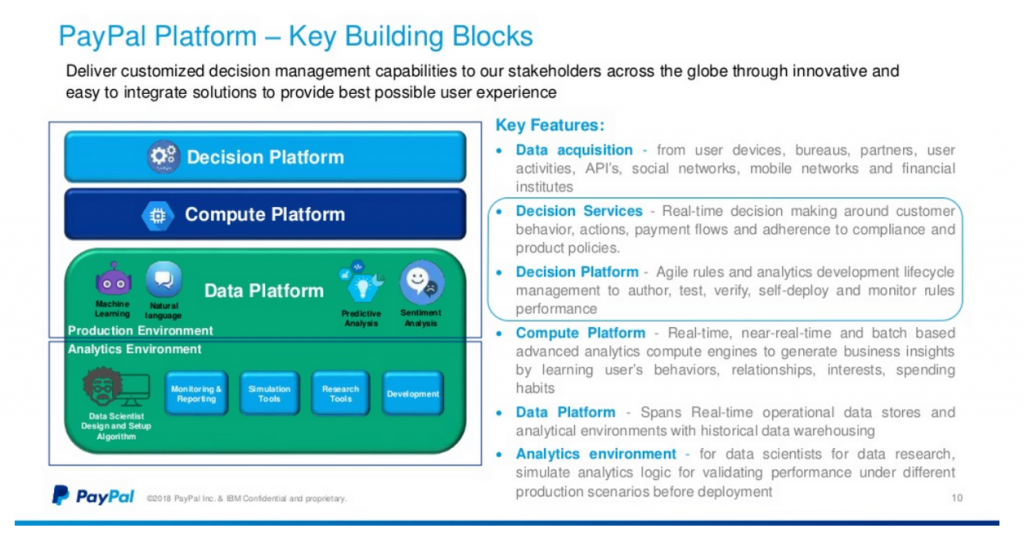Cloud
Towards Intelligent Business Automation with Business Rules and Machine Learning
29/04/2020 | Written by: Wim Peeters and Francis Friedlander
Categorized: Cloud
Share this post:
Many businesses think they took the big step towards business automation a long time ago. Technically, that is true, a long time ago. The next step in business automation is actual automation of the business and that’s were IBM Digital Business Automation comes in using techniques like artificial intelligence and machine learning.
The IBM Digital Business Automation offering combines several capabilities, including workflows, content management and decision automation with IBM Operational Decision Manager. IBM ODM is a platform that enables businesses to define the rules of the digital decisions they make. This may sound complicated and techy, but it is meant to involve non it-personnel or, as Francis Friedlander, Decision Automation Expert at IBM, puts it: “With this technology, business rules are transparent and easy to change. If you need some business agility in the logic behind your decisions, business rules changes can be done by the business users themselves, which is important because regulations, market conditions and best practices evolve continuously.”
Friedlander likes to talk about his work and its many challenges due to its broad portfolio of businesses, from companies in the finance or retail sector to government institutions. Together with Wim Peeters, Tech Sales Leader BeNeLux for Automation, he gives a little insight in the workings of IBM ODM and related technologies, like Robotic Process Automation, and IBM Business Automation Insights.
From month to minutes
Peeters gives an example on systems to check eligibility for benefits. In most countries those systems are old, legacy systems with which it might take between 9 and 12 months to change a simple thing: “Imagine there is a law which changes a certain aspect from 26 to 25 weeks, that could take many months to process in the legacy systems”, he says. “With IBM we made it possible to separate the business logic from the legacy systems , which is a huge advantage, because now you can plan a change in advance, for instance when a law changes, you can have an analyst change the actual rule before the law comes into effect. A major advantage, from months to minutes.”
Another huge advantage is running simulations from historical data and see what the consequences of new rules are. “At the moment we don’t use machine learning or artificial intelligence in these systems yet, but that would be a good next step”, says Peeters.
Friedlander agrees: “With Machine Learning, you can build predictive models and train them on historical data, for example to identify potential fraudsters. But the problem is that machine learning makes choices but can’t justify them. You cannot see how it came to its decisions or where possible biases come from. When someone is tagged as a possible fraudster, you cannot tell how the machine came to its decision.”
The problem of not knowing how an artificial intelligence came to its decisions, has fortunately been tackled to some extent, Friedlander: “IBM offers a platform called IBM Watson OpenScale, which is capable of addressing this issue of not knowing how AI came to its conclusions. IBM Watson OpenScale can tell you what attributes were key in the outcome of ML, but if you need to also know how these attributes influenced the decision, you need rules.”
Experts author rules not only with execution, but also with maintenance in mind. Apart from the capability of understanding what happened when the decision engine made a particular rule-based decision, it is also possible and natural for business analysts to make changes to the decision making model. Friedlander gives an example of a marketing expert changing the rules due to local competition.
“Think about a city like Utrecht where many students live. Imagine an insurance business deciding to apply a ten percent discount in Utrecht in policies due to local competition. Business analysts will need to write those discount rules. Fortunately, you don’t need a specialized IT-department to alter those rules, the marketing department can do this easily.”
“Now, the business analysts run simulations with these new business rules and the system will come up with KPIs on the revenue and other business impact of the change. Simulation in IBM ODM uses historical data to determine the business impact of changes in the business rules.”
Combining human-crafted rules and Machine Learning models trained on data
There is a very powerful pattern, namely the combination of machine learning and business rules written by humans. ODM clients have been authoring, validating and running rules that apply to explicit client data from the CRM. Machine Learning can predict how a customer may respond to a product recommendation, whether he or she is likely to leave to the competition or to buy a car. This leads naturally to a ‘very powerful marriage between business rules and machine learning where business rules consume insight resulting from Machine Learning’, according to Friedlander.
“Rules capture common sense, policies, best practices and agreement while Machine Learning models learn from structured and unstructured data, and combining them is a powerful combination. To go further in that direction, IBM has recently launched a Technology Preview of IBM Automation Decision Services (ADS), a new born-in-the-cloud digital decisioning component with a built-in feature to invoke Machine Learning models from rule-based decisions. ADS is intended to be part of a future IBM Cloud Pak for Automation release.”
PayPal
Fintech company PayPal presented its experiences with the use of ODM and ML and big data techniques recently on a Think! conference. They use the technique to deliver better customized decision management capabilities to their stakeholders across the globe. This led to better focus on the customer and in the end a happier customer.
PayPal focused a lot on customer protection, like protection from fraudulent users, and safe payments. Now the company uses much more different parameters to stay in touch with its customer. They use data acquisition from different devices and social networks and combine this with real-time decision-making services around customer behavior. A decision platform manages agile rules and analytics development to author, test, verify, self-deploy and monitor rules performance. Everything in combination with the compute and data platform. The back end is the analytics environment for data scientists for things like data research and analytics of the logic behind the decision making.

Simulation
The word ‘simulation’ is recurring in Friedlander’s words. He highlights an example of using business rules and machine learning in the context of a call center. In this case he talks about assigning new business rules with the help ODM, using legacy data for the simulation.
“Simulation is a very powerful capability to ensure that the changes business analysts apply to digital decisions and the impact of these changes remain under control.”, continues Friedlander. “When you want to change some business rules, you want them to have a positive and known effect on your business”, he says. The call center case is a clear example of a complex situation where business automation adds a lot of value. You want to route calls, taking into account who is calling, what the reason of the call is and what the agent pool looks like. There are two different types of customers: platinum and gold. Right now, all platinum users get to talk to the super-expert immediately and gold members to the regular expert, but for cost optimization or marketing reasons the company wants to route gold member calls to super experts as well. That might become a painstaking exercise: do you need to train the regular experts better? Get overworked super-experts? Or is it better to change the business rules and distribute the calls differently?
“Now, we want to predict the impact of this change on the agent utilization and on the client experience “, says Friedlander. “And that’s where simulation comes in. We simulate using the data from the previous year and so we can repeat the simulation many times and see in what way we could alter the business rules in order to get the best distribution of calls from a financial or client satisfaction standpoint.” The importance of using legacy data is clear: “You cannot invent the calls, the reality is always different and with legacy data you have the reality of what is most likely to happen in the future. Future distribution of cases should somehow be comparable to past distributions, and you can invent missing data by applying data science techniques.”
ODM typically acts in the backend to make decisions, but it makes also sense to use ODM in the engagement layer which understands what the client means and what his intentions are. These systems rely heavily on AI and machine learning or robotic process automation, or RPA. And if an action must be handled in the backoffice in the course of conversation, the chatbot can route the call. Bots are a good example where AI and rule-based decisions play together: they need to recognize unstructured documents or voice and decide who the right person is to handle the request, in our case study to the expert or super expert.
All in all there is a lot to digital business automation. Not sure where to start? Try IBM’s Decisions Composer, a no-cost cloud-based tool to help you model, author, validate, share and run business rules in a no-code environment.
Wil je de nieuwsbrief IBM Automation Insider ontvangen?
Schrijf je dan hier in >

Cloud Integration & Automation Technical Leader, Benelux

Business Automation, Automation Intelligence and Decision Management Technical Expert, Europe
IBM-onderzoek: één leverancier voor Cloud is achterhaald
Branche gerelateerde regelgeving wordt gezien als een belangrijk obstakel voor Cloud adoptie door 68 procent van de respondenten. Eén derde van de respondenten ziet security niet als topprioriteit ondanks cyberaanvallen. Uit nieuw wereldwijd onderzoek van IBM (blijkt dat er een drastische verschuiving heeft plaatsgevonden in de zakelijke behoeften van Cloud omgevingen. Slechts één procent […]
Take out complexity and deliver business value with hybrid multicloud
Taking cloud to scale has proven a challenge for many organizations. 60% of European organizations are still running their business-critical application on-premise, and have not yet moved the majority of applications in a hybrid or multicloud architecture, according to IDC’s 2021 Multicloud survey of 925 IT and business decision makers from across Europe from […]
Together to the top – with future ready business applications
Fast-track your hybrid cloud transformation to Microsoft Azure with security and confidence Being partners with Microsoft for 30 years and having integrated with Redhat and Nordcloud, we at IBM Benelux thought it was high time to get together and do a webinar. Maybe a webinar is not one of the most original type of […]


